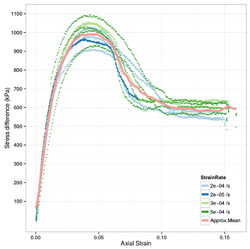
Back Dilatanz (granulare Materie) German Dilatancia Spanish Dilatance French 층밀림 늘기 Korean Дилатансия Russian Дилатансія Ukrainian

In soil mechanics, dilatancy or shear dilatancy[1] is the volume change observed in granular materials when they are subjected to shear deformations.[2][3] This effect was first described scientifically by Osborne Reynolds in 1885/1886[4][5] and is also known as Reynolds dilatancy. It was brought into the field of geotechnical engineering by Peter Walter Rowe [de].[6]
Unlike most other solid materials, the tendency of a compacted dense granular material is to dilate (expand in volume) as it is sheared. This occurs because the grains in a compacted state are interlocking and therefore do not have the freedom to move around one another. When stressed, a lever motion occurs between neighboring grains, which produces a bulk expansion of the material. On the other hand, when a granular material starts in a very loose state it may continuously compact instead of dilating under shear. A sample of a material is called dilative if its volume increases with increasing shear and contractive if the volume decreases with increasing shear.[7][8]
Dilatancy is a common feature of soils and sands. Its effect can be seen when the wet sand around the foot of a person walking on beach appears to dry up. The deformation caused by the foot expands the sand under it and the water in the sand moves to fill the new space between the grains.
- ^ Tighe, Brian P. (April 2014). "Shear dilatancy in marginal solids". Granular Matter. 16 (2): 203–208. arXiv:1305.5574. doi:10.1007/s10035-013-0436-6.
- ^ Nedderman, R. M. (1992). Statics and Kinematics of Granular Materials. doi:10.1017/CBO9780511600043. ISBN 978-0-521-40435-8.[page needed]
- ^ Andreotti, Bruno; Forterre, Yoël; Pouliquen, Olivier (2013). Granular Media: Between Fluid and Solid. Cambridge University Press. ISBN 978-1-107-03479-2.[page needed]
- ^ Reynolds, Osborne (December 1885). "LVII. On the dilatancy of media composed of rigid particles in contact. With experimental illustrations". The London, Edinburgh, and Dublin Philosophical Magazine and Journal of Science. 20 (127): 469–481. doi:10.1080/14786448508627791.
- ^ Reynolds, Osborne (12 February 1886). Experiments showing dilatancy, a property of granular material, possibly connected with gravitation. Royal Institution of Great Britain. Weekly evening meeting. OCLC 1440246508.
- ^ Rowe, P. W. (9 October 1962). "The stress-dilatancy relation for static equilibrium of an assembly of particles in contact". Proceedings of the Royal Society of London. Series A. Mathematical and Physical Sciences. 269 (1339): 500–527. Bibcode:1962RSPSA.269..500R. doi:10.1098/rspa.1962.0193.
- ^ Casagrande, A., Hirschfeld, R. C., & Poulos, S. J. (1964). Fourth Report: Investigation of Stress-Deformation and Strength Characteristics of Compacted Clays. HARVARD UNIV CAMBRIDGE MA SOIL MECHANICS LAB.
- ^ Poulos, S. J. (1971). The stress-strain curves of soils. Geotechnical Engineers Incorporated. Chicago.